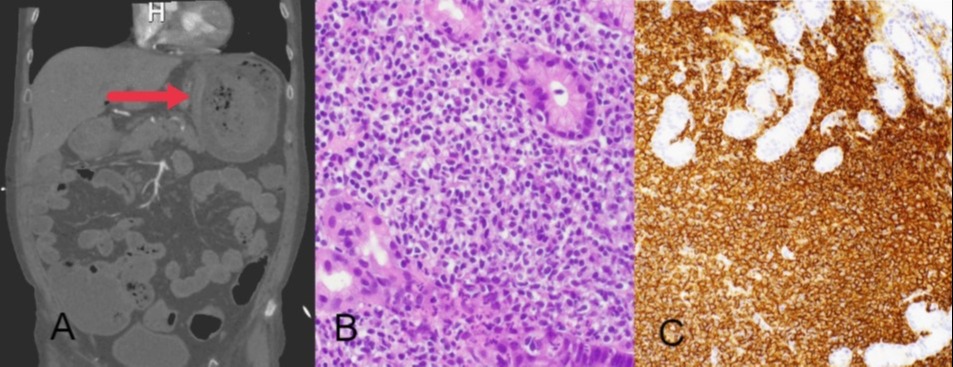Tuesday Poster Session
Category: Stomach
P4236 - Upper Gastrointestinal Bleeding as a Rare Acute Presentation of Underlying Gastric Lymphoma
Tuesday, October 24, 2023
10:30 AM - 4:00 PM PT
Location: Exhibit Hall

Has Audio
- AA
Abdul Arham, MBBS, MD
UMass Chan-Baystate Medical Center
Springfield, MA
Presenting Author(s)
Muhammad Sohaib, MD1, Syed Hamaad Rahman, DO2, Nihal Ijaz Khan, MD3, Abdul Arham, MBBS, MD4
1Parkview Medical Center, Pueblo, CO; 2Methodist Dallas Medical Center, Dallas, TX; 3AdventHealth, Orlando, FL; 4UMass Chan-Baystate Medical Center, Springfield, MA
Introduction: Primary gastric lymphomas (PGL) are exceedingly rare, making up approximately 3% of gastric neoplasms and 10% of all lymphomas. PGLs are divided into mucosa-associated lymphoid tissue (MALT) lymphomas and diffuse large B-cell lymphomas (DLBCL). MALT lymphomas account for 40% of PGLs. While many patients who are diagnosed with gastric MALT lymphomas present with chronic symptoms, this case is interesting in that our patient’s initial presentation leading to diagnosis was a massive gastrointestinal bleed and hypovolemic shock that required aggressive resuscitation.
Case Description/Methods: A 75-year-old male with a history of hypertension and bloody bowel movements presented to the emergency department after having a syncopal episode. Emergency medical services noted that the patient was semi-conscious with a blood pressure of 58/29. Intravenous fluids and vasopressors were administered to the patient. Laboratory tests revealed a hemoglobin of 8.6 and lactic acidosis. A contrast CT scan of the abdomen and pelvis was notable for a deep gastric ulcer along the proximal lesser curvature of the stomach with adjacent gastric hepatic ligament lymphadenopathy.
An EGD was performed which revealed multiple non-bleeding gastric ulcers with visible vessels, which were treated with cautery. Histopathological analysis of the biopsy samples identified atypical B-lymphocytic infiltrate positive for CD43, BCL2 and IGH rearrangement. FISH testing revealed t(11;18) translocation, characteristic of MALT lymphoma. H. pylori was not detected.
The patient was sent home on H. pylori eradication triple therapy and was instructed to follow up with hematology and oncology for further staging.
Discussion: Gastric MALT lymphoma is a rare condition characterized by B-cell proliferation and infiltration of lymphoid tissue, resulting in the destruction of gastric glands. The link between gastric MALT lymphoma and H. pylori infection has been extensively documented. However, our patient belongs to the minority who are diagnosed with gastric MALT lymphoma without underlying H. pylori gastritis. Our case emphasizes the possibility of considering H. pylori therapy even in H. pylori-negative patients before resorting to more aggressive and costly treatments. While gastric MALT lymphomas typically manifest with chronic symptoms like gastrointestinal upset or abdominal pain, our case underscores the importance of recognizing that acute presentations of this disease can also occur.

Disclosures:
Muhammad Sohaib, MD1, Syed Hamaad Rahman, DO2, Nihal Ijaz Khan, MD3, Abdul Arham, MBBS, MD4. P4236 - Upper Gastrointestinal Bleeding as a Rare Acute Presentation of Underlying Gastric Lymphoma, ACG 2023 Annual Scientific Meeting Abstracts. Vancouver, BC, Canada: American College of Gastroenterology.
1Parkview Medical Center, Pueblo, CO; 2Methodist Dallas Medical Center, Dallas, TX; 3AdventHealth, Orlando, FL; 4UMass Chan-Baystate Medical Center, Springfield, MA
Introduction: Primary gastric lymphomas (PGL) are exceedingly rare, making up approximately 3% of gastric neoplasms and 10% of all lymphomas. PGLs are divided into mucosa-associated lymphoid tissue (MALT) lymphomas and diffuse large B-cell lymphomas (DLBCL). MALT lymphomas account for 40% of PGLs. While many patients who are diagnosed with gastric MALT lymphomas present with chronic symptoms, this case is interesting in that our patient’s initial presentation leading to diagnosis was a massive gastrointestinal bleed and hypovolemic shock that required aggressive resuscitation.
Case Description/Methods: A 75-year-old male with a history of hypertension and bloody bowel movements presented to the emergency department after having a syncopal episode. Emergency medical services noted that the patient was semi-conscious with a blood pressure of 58/29. Intravenous fluids and vasopressors were administered to the patient. Laboratory tests revealed a hemoglobin of 8.6 and lactic acidosis. A contrast CT scan of the abdomen and pelvis was notable for a deep gastric ulcer along the proximal lesser curvature of the stomach with adjacent gastric hepatic ligament lymphadenopathy.
An EGD was performed which revealed multiple non-bleeding gastric ulcers with visible vessels, which were treated with cautery. Histopathological analysis of the biopsy samples identified atypical B-lymphocytic infiltrate positive for CD43, BCL2 and IGH rearrangement. FISH testing revealed t(11;18) translocation, characteristic of MALT lymphoma. H. pylori was not detected.
The patient was sent home on H. pylori eradication triple therapy and was instructed to follow up with hematology and oncology for further staging.
Discussion: Gastric MALT lymphoma is a rare condition characterized by B-cell proliferation and infiltration of lymphoid tissue, resulting in the destruction of gastric glands. The link between gastric MALT lymphoma and H. pylori infection has been extensively documented. However, our patient belongs to the minority who are diagnosed with gastric MALT lymphoma without underlying H. pylori gastritis. Our case emphasizes the possibility of considering H. pylori therapy even in H. pylori-negative patients before resorting to more aggressive and costly treatments. While gastric MALT lymphomas typically manifest with chronic symptoms like gastrointestinal upset or abdominal pain, our case underscores the importance of recognizing that acute presentations of this disease can also occur.

Figure: A: Focal wall thickening (red arrow) along the proximal lesser curvature of stomach. B: Hematoxylin and eosin stain 40x showing atypical infiltrates. C: CD20 stain 20x showing increased B lymphocytic infiltrate.
Disclosures:
Muhammad Sohaib indicated no relevant financial relationships.
Syed Hamaad Rahman indicated no relevant financial relationships.
Nihal Ijaz Khan indicated no relevant financial relationships.
Abdul Arham indicated no relevant financial relationships.
Muhammad Sohaib, MD1, Syed Hamaad Rahman, DO2, Nihal Ijaz Khan, MD3, Abdul Arham, MBBS, MD4. P4236 - Upper Gastrointestinal Bleeding as a Rare Acute Presentation of Underlying Gastric Lymphoma, ACG 2023 Annual Scientific Meeting Abstracts. Vancouver, BC, Canada: American College of Gastroenterology.
